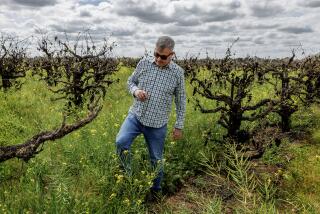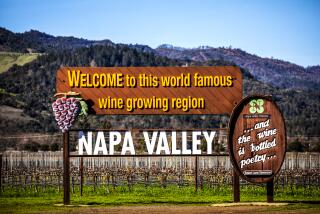Vintners plant solar panels alongside grapes
Clusters of harvest-ready grapes, pendulous and purple, dangle among deep green leaves at Frog’s Leap winery in Rutherford, Calif., waiting to become Napa Valley wine.
But a few rows over is a plant of a different kind -- an array of square-faced solar panels that provide the power to keep operations humming.
Winemakers in Napa Valley and elsewhere are bottling sunshine in more ways than one this year.
“We tend to be massive power consumers during the harvest. It’s particularly gratifying that’s the time we’re producing the most power,” said John Williams, founder of Frog’s Leap.
“It’s an absolute natural for the wine industry,” said Ted Hall, president and co-owner of Long Meadow Ranch, a Napa Valley winery and olive oil producer also run by solar power.
Factors driving the California winery solar connection include relatively high electricity rates coupled with abundant sunshine. Wineries make good candidates for solar power because they tend to use power when it’s sunniest, at harvest.
And with the threat of global warming looming, vintners have a strong incentive not to do anything to contribute to climate change that could spoil growing conditions, said Bernadette Del Chiaro, clean energy advocate with Environment California.
Installing solar isn’t cheap, but with rebates available and a system that allows vintners to plug directly into the conventional grid, rather than having to pay for and deal with storage batteries, the option is becoming attractive to a number of wineries.
“As an industry, they are definitely a leader in harnessing the sun,” said Rhone Resch, president of the Washington-based Solar Energy Industries Assn.
Rob Erlichman, founder of San Francisco-based Sunlight Electric, estimates that there are 28 systems in Napa County and another 14 in next-door Sonoma County. His company has more than a dozen wineries as clients, including Long Meadow and Frog’s Leap.
“This thing has really picked up a head of steam in the last couple of years,” he said.
Space is at a premium in the vineyards, which has prompted some innovative installations, such as pole-mounted arrays at the end of vine rows and a parking shade structure built expressly to install solar panels, Erlichman said.
At Frog’s Leap, the space crunch was solved by putting the solar array over a leach field.
In Oakville, the Far Niente winery is trying out a new approach in the volts-for-vines trade-off, saving grape space by putting some panels on the ground but also installing an array that will float on an irrigation pond.
The Floatovoltaic System, being installed by SPG Solar of San Francisco and scheduled to be up and running by year’s end, also shades the pond, which is expected to keep algae growth down.
“I’m so excited about it,” said Dan Thompson, SPG chief executive. “It has every advantage.”
Solar power in California, and in many other states, works on a “net metering” basis. Producers are hooked up to the main grid. When they are producing more energy than they’re using, the surplus goes into the grid and is used by customers elsewhere. At night, or when they’re using more power than they are producing, the solar customers draw energy from the grid.
At year’s end, the books are balanced, and if solar-power customers used more power than they produced, they are billed for the difference.
The advantage for wineries is that they get to fix energy costs, selling when rates are high and buying when they are low. Still, that doesn’t mean installing solar power is an easy decision.
Even with subsidies and tax breaks, it’s still a big chunk of cash that could have been spent on vineyards, said Larry Maguire, a partner and president of Far Niente.
“If it was just the pure economics of it, we wouldn’t be doing this,” he said. “You have to do it because you’re motivated and you feel responsible.”
Responsibility includes stepping up conservation efforts. An energy audit is required to qualify for rebates and many vintners have gone further in looking for ways to minimize energy use.
The new hospitality center at Frog’s Leap, for instance, is heated and cooled by geothermal energy derived from the Earth’s thermal mass through an underground loop system.
At Long Meadow, Hall is bringing in an electric 2-ton delivery truck that will be charged with power produced by the ranch’s solar arrays.
“It’s literally a zero carbon imprint,” he said.
Industry advocate Resch will be doing his part.
“I only drink wine from solar wineries,” he said.
More to Read
Inside the business of entertainment
The Wide Shot brings you news, analysis and insights on everything from streaming wars to production — and what it all means for the future.
You may occasionally receive promotional content from the Los Angeles Times.










